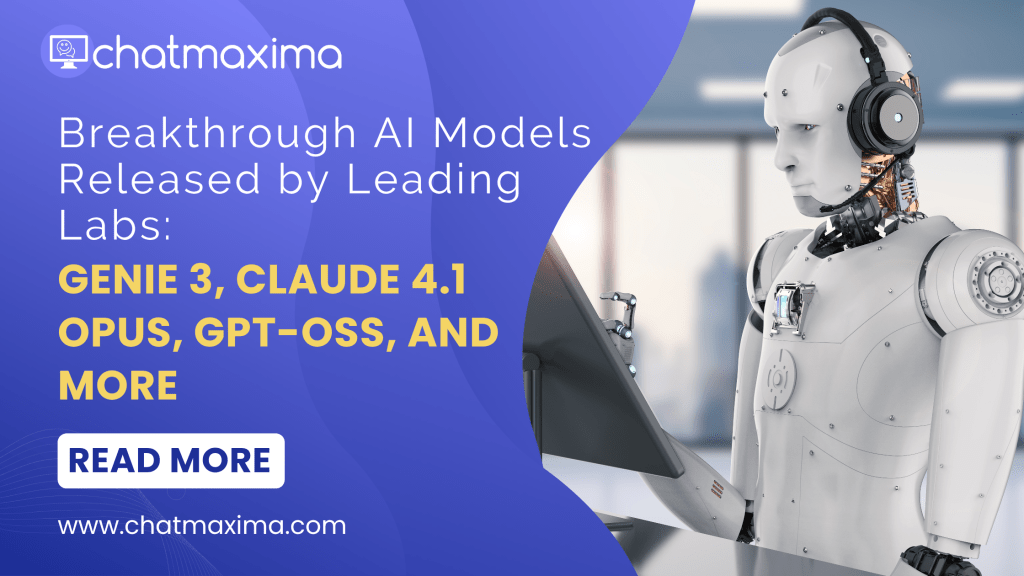This week marked a defining moment in the evolution of artificial intelligence. In just a matter of hours, a wave of powerful new models was released by the world’s top AI labs, triggering a flurry of excitement across the global tech community. With names like Genie 3, Claude 4.1 Opus, Qwen3-Coder-Flash, and GPT-OSS-120b now etched into the AI timeline, this was more than a typical day – it was a technological turning point.
Let’s break down what happened, why it matters, and where we’re headed next.
A Flood of Innovation: Today’s Major AI Releases
The dominoes started falling early in the day, with developers quickly taking note of the gravity of what had just unfolded. The list of releases included: Genie 3, Claude 4.1 Opus, Qwen3-Coder-Flash, Qwen-Flash, GPT-OSS-120b, and GPT-OSS-20b. That quote alone sums up the historic scale of this release cycle.
DeepMind’s Genie 3: Interactive Worlds in Real Time
Arguably the most visually impressive launch came from DeepMind. Genie 3 is a real-time “world model” that can generate interactive 3D simulations at 720p resolution and 24 fps, all through natural language prompts or image inputs. The model allows users to modify weather, introduce new characters, and simulate diverse scenarios, not for gaming, but to serve as dynamic training grounds for AI agents.
Genie 3 promises to be a powerful research tool, providing endlessly configurable virtual environments that could revolutionize robotics, autonomous systems, and reinforcement learning research.
Anthropic’s Claude 4.1 Opus: Coding, Elevated
Claude 4.1 Opus by Anthropic continues the company’s strong performance in AI development, with a model tailored for high-precision coding tasks and technical problem solving. The upgrade includes features like code execution, prompt caching, a Files API, and a new MCP connector, enabling seamless integration into development workflows.
Early feedback from tools like Cursor and Replit shows that Claude 4.1 Opus excels in complex code refactoring and systems engineering. With this, Anthropic positions itself as a serious contender for powering future dev environments.
Qwen and GPT-OSS: Open Source Titans
On the open-source front, Alibaba released two models: Qwen3-Coder-Flash and Qwen-Flash. Optimized for speed and efficiency, these models are already seeing integration with tools like Claude Code. They reflect a growing push to make high-performance coding models more accessible and customizable.
Meanwhile, OpenAI dropped its GPT-OSS-120b and GPT-OSS-20b models, massive open-weight releases featuring Mixture-of-Experts (MoE) architecture. These models, available on Hugging Face, are touted as “state-of-the-art” and are optimized for scaling and distributed inference.
What It All Means: A Shift in Trajectory
Today’s rapid-fire launches suggest more than just healthy competition. They reflect a shift from iterative improvement to disruptive change. A recent study revealed that AI performance has been doubling every 8-10 months, a trend that these releases seem to confirm.
This is likely driven by breakthroughs in MoE architecture, better hardware utilization, and a shift toward multi-modal and real-time interaction. The sheer scale and coordination of releases across companies hints at a new era where collaboration and competition merge to push boundaries further and faster.
Community Reactions: A Global Frenzy
Social media captured the chaos and joy. From memes to in-depth technical threads, the community lit up with reactions. Users from around the world tuned in to explore these developments and share insights.
This organic reaction highlights how deeply intertwined AI development has become with global developer culture.
Looking Ahead: Practical Integration and Ethical Considerations
The real question now is how these tools will be used. Genie 3 may become a staple in robotics research. Claude 4.1 Opus could empower enterprise software development. Open-weight models like GPT-OSS might democratize AI research and development across the globe.
Yet with power comes responsibility. These models are large and compute-intensive. Their energy consumption, bias management, and ethical deployment must now take center stage. As we move forward, responsible use and open governance will be as crucial as the innovations themselves.
Conclusion: The Dawn of a New AI Epoch
This was not just another day. It marked a paradigm shift in AI, driven by groundbreaking releases from DeepMind, Anthropic, Alibaba, and OpenAI. From simulated environments and advanced code execution to scalable, open-weight architectures, the world of AI has undeniably leveled up.
Now, it is up to developers, researchers, and organizations to turn these tools into transformative applications. Whether you are diving into Genie 3’s 3D realms or building with Claude 4.1 Opus, the future is here and it is accelerating.
What will you build next?


